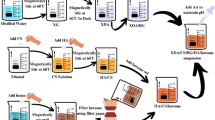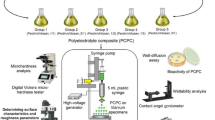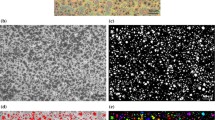Abstract
Metallic prostheses are the most used for the partial or total recovery of damaged organs and tissues, with titanium being the most applied material. Aiming to enhance the device to be implanted, the application of polymeric and ceramic coatings has been studied. The use of polycaprolactone (PCL) has shown promising characteristics, given its biodegradability, and the addition of hydroxyapatite (HA) has favored osseointegration. Nevertheless, complications related to infectious processes are recurrent to surgical procedures. In this context, the present study proposes the manufacture of a functional hybrid material for prosthetic application. As a strategy to minimize postsurgical bacterial contamination, this work proposes the incorporation of Melaleuca alternifolia essential oil (TTO) as a natural bactericide, in polycaprolactone and hydroxyapatite coatings in a titanium substrate. The samples were characterized to demonstrate that the coatings were performed on the whole surface of the titanium and that the incorporation of the essential oil did not alter the morphology of the polymeric film. The surface morphological evaluation performed after the corrosion assays in simulated body fluid indicated there was PCL degradation, being more intense for the samples containing HA, deriving from the alteration in the polymeric coating hydrophilicity combined with the bioceramic and the increase in surface porosity. Simultaneously to the process of polymeric layer degradation, it is suggested that there will be a release of the TTO incorporated in PCL and the formation of overlapping apatitic layers. Therefore, the results demonstrated that the proposed coatings may contribute to biocompatibility and the osseointegrative process, indicating the potentiality for application in orthopedic medical devices.






Similar content being viewed by others
References
A. Dolcimascolo, G. Calabrese, S. Conoci, and R. Parenti, Innovative Biomaterials for Tissue Engineering. In Biomaterial-supported Tissue Reconstruction or Regeneration (IntechOpen, 2019). doi:https://doi.org/10.5772/intechopen.83839
I.C.P. Rodrigues, A. Kaasi, R. Maciel Filho, A.L. Jardini, and L.P. Gabriel, Cardiac Tissue Engineering: Current State-of-the-Art Materials, Cells and Tissue Formation, Einstein (São Paulo), 2018, 16, p eRB4538.
M.S.B. Reddy, D. Ponnamma, R. Choudhary, and K.K. Sadasivuni, A Comparative Review of Natural and Synthetic Biopolymer Composite Scaffolds, Polym. (Basel), 2021, 13, p 1105.
M.N. Collins et al., Scaffold Fabrication Technologies and Structure/Function Properties in Bone Tissue Engineering, Adv. Funct. Mater., 2021, 31, p 2010609.
G.K. Sharma, V. Kukshal, D. Shekhawat, and A. Patnaik, Fabrication and Characterization of Metallic Biomaterials in Medical Applications. In Advanced Materials and Manufacturing Processes 95–105 (CRC Press, 2021). https://doi.org/10.1201/9781003093213-6
U. Filipović, R.G. Dahmane, S. Ghannouchi, A. Zore, and K. Bohinc, Bacterial Adhesion on Orthopedic Implants, Adv. Colloid Interface Sci., 2020, 283, p 102228.
S. Ali et al., Biocompatibility and Corrosion Resistance of Metallic Biomaterials, Corros. Rev., 2020, 38, p 381–402.
W. Liu, S. Liu, and L. Wang, Surface Modification of Biomedical Titanium Alloy: Micromorphology Microstructure Evolution and Biomedical Applications, Coatings, 2019, 9, p 249.
M.H. Prado da Silva, Osteoinductive Biomaterials, Ref. Module Mater. Sci. Mater. Eng., 2016 https://doi.org/10.1016/B978-0-12-803581-8.04087-X
Y. Chen et al., Mechanical Properties and Biocompatibility of Porous Titanium Scaffolds for Bone Tissue Engineering, J. Mech. Behav. Biomed. Mater., 2017, 75, p 169–174.
E.V. Melnik et al., In Vitro Degradation Behaviour of Hybrid Electrospun Scaffolds of Polycaprolactone and strontium-Containing Hydroxyapatite Microparticles, Polym. Degrad. Stab., 2019, 167, p 21–32.
Y. Chen, D. Kent, M. Bermingham, A. Dehghan-Manshadi, and M. Dargusch, Manufacturing of Biocompatible Porous Titanium Scaffolds Using a Novel Spherical Sugar Pellet Space Holder, Mater. Lett., 2017, 195, p 92–95.
M.T. Frassica and M.A. Grunlan, Perspectives on Synthetic Materials to Guide Tissue Regeneration for Osteochondral Defect Repair, ACS Biomater. Sci. Eng., 2020, 6, p 4324–4336.
B. Safari, M. Aghazadeh, L. Roshangar, A. Aghanejad, and S. Davaran, A Bioactive Porous Scaffold Containing Collagen/Phosphorous-Modified Polycaprolactone for Osteogenesis of Adipose-Derived Mesenchymal Stem Cells, Eur. Polym. J., 2022, 171, p 111220.
X. Ma et al., Titanium Implants and Local Drug Delivery Systems Become Mutual Promoters in Orthopedic Clinics, Nanomaterials, 2022, 12, p 47.
P.X. Ma, Biomimetic Materials for Tissue Engineering, Adv. Drug Deliv. Rev., 2008, 60, p 184–198.
M.F. Mohd Yusoff, M.R. Abdul Kadir, N. Iqbal, M.A. Hassan, and R. Hussain, Dipcoating of Poly (ε-Caprolactone)/Hydroxyapatite Composite Coating on Ti6Al4V for Enhanced Corrosion Protection, Surf. Coatings Technol., 2014, 245, p 102–107.
N.S. Manam et al., Study of Corrosion in Biocompatible Metals for Implants: A Review, J. Alloys Compd., 2017, 701, p 698–715.
I.E. Glazov et al., Effect of Platelet-Poor Plasma Additive on the Formation of Biocompatible Calcium Phosphates, Mater. Today Commun., 2021, 27, p 102224.
V.K. Krut’ko et al., Physicochemical Properties and Structure of the Bone Matrix in Simulated Tuberculous Osteitis, Tech. Phys., 2019, 64, p 121–126.
C.C. Ferreira et al., Titanium Biomimetically Coated With Hydroxyapatite, Silver Nitrate and Polycaprolactone, for Use In Biomaterials (Biomedicine), Mater. Res., 2019, 22, p 20190177.
S. Wang et al., Tuning Pore Features of Mineralized Collagen/PCL Scaffolds for Cranial Bone Regeneration in a Rat Model, Mater. Sci. Eng. C, 2020, 106, p 110186.
A. Kiran, T. S. Kumar, R. Sanghavi, M. Doble, and S. Ramakrishna, Antibacterial and Bioactive Surface Modifications of Titanium Implants by PCL/TiO2 Nanocomposite Coatings. Nanomaterials, 2018, 8, p 860.
N. Singh, U. Batra, K. Kumar, and A. Mahapatro, Investigating TiO2–HA–PCL Hybrid Coating as an Efficient Corrosion Resistant Barrier of ZM21 Mg Alloy, J. Magnes. Alloy., 2021, 9, p 627–646.
Z. Khatoon, C.D. McTiernan, E.J. Suuronen, T.-F. Mah, and E.I. Alarcon, Bacterial Biofilm Formation on Implantable Devices and Approaches to its Treatment and Prevention, Heliyon, 2018, 4, p e01067.
J. Raphel, M. Holodniy, S.B. Goodman, and S.C. Heilshorn, Multifunctional Coatings to Simultaneously Promote Osseointegration and Prevent Infection of Orthopaedic Implants, Biomaterials, 2016, 84, p 301–314.
O. Bazaka et al., Effect of Titanium Surface Topography on Plasma Deposition of Antibacterial Polymer Coatings, Appl. Surf. Sci., 2020, 521, p 146375.
W.-L. Low, K. Kenward, S.T. Britland, M.C. Amin, and C. Martin, Essential Oils and Metal Ions as Alternative Antimicrobial Agents: A Focus on Tea Tree Oil and Silver, Int. Wound J., 2017, 14, p 369–384.
U.T. Khatoon, G.V.S. Nageswara Rao, K.M. Mohan, A. Ramanaviciene, and A. Ramanavicius, Antibacterial and Antifungal Activity of Silver Nanospheres Synthesized by Tri-Sodium Citrate Assisted Chemical Approach, Vacuum, 2017, 146, p 259–265.
U.T. Khatoon, G.V.S.N. Rao, M.K. Mohan, A. Ramanaviciene, and A. Ramanavicius, Comparative Study of Antifungal Activity of Silver and gold Nanoparticles Synthesized by Facile Chemical Approach, J. Environ. Chem. Eng., 2018, 6, p 5837–5844.
J. Baptiste Hzounda Fokou, P. Michel Jazet Dongmo, and F. Fekam Boyom, Essential Oil’s Chemical Composition and Pharmacological Properties, Essent. Oils Oils Nat., 2020 https://doi.org/10.5772/intechopen.86573
L.G. Mugao, B.M. Gichimu, P.W. Muturi, and S.T. Mukono, Characterization of the Volatile Components of Essential Oils of Selected Plants in Kenya, Biochem. Res. Int., 2020, 2020, p 1–8.
P.M. Maquera-Huacho et al., In Vitro Antibacterial and Cytotoxic Activities of Carvacrol and Terpinen-4-ol Against Biofilm Formation on Titanium Implant Surfaces, Biofouling, 2018, 34, p 699–709.
N. Puvača, I. Čabarkapa, V. Bursić, A. Petrović, and M. Aćimović, Antimicrobial, Antioxidant and Acaricidal Properties of Tea Tree (Melaleuca alternifolia), Technol. Eng. Manag., 2018, 1, p 29–38.
T. Kokubo and S. Yamaguchi, Novel Bioactive Materials Developed by simulated Body Fluid Evaluation: Surface-Modified Ti Metal and its Alloys, Acta Biomater., 2016, 44, p 16–30.
C.C. Ferreira et al., Improvement of Titanium Corrosion Resistance by Coating with Poly-Caprolactone and Poly-Caprolactone/Titanium Dioxide: Potential Application in Heart Valves, Mater. Res., 2018, 20, p 126–133.
L. Jonášová, F.A. Müller, A. Helebrant, J. Strnad, and P. Greil, Biomimetic Apatite Formation on Chemically Treated Titanium, Biomaterials, 2004, 25, p 1187–1194.
T. Kokubo and H. Takadama, Simulated Body Fluid (SBF) as a Standard Tool to Test the Bioactivity of Implants, Handb. Biominer., 2008, 3, p 97–109.
S. Maher, A. Mazinani, M.R. Barati, and D. Losic, Engineered Titanium Implants for Localized Drug Delivery: Recent Advances and Perspectives of Titania Nanotubes Arrays, Expert Opin. Drug Deliv., 2018, 15, p 1021–1037.
R. Tejero, E. Anitua, and G. Orive, Toward the Biomimetic Implant Surface: Biopolymers on Titanium-Based Implants for Bone Regeneration, Prog. Polym. Sci., 2014, 39, p 1406–1447.
G. Schmidmaier et al., Bone Morphogenetic Protein-2 Coating of Titanium Implants Increases Biomechanical Strength and accelerates Bone Remodeling in Fracture Treatment: A Biomechanical and Histological Study in Rats, Bone, 2002, 30, p 816–822.
V. Zarghami, M. Ghorbani, K.P. Bagheri, and M.A. Shokrgozar, Prevention the Formation of Biofilm on Orthopedic Implants by Melittin Thin Layer on Chitosan/Bioactive Glass/Vancomycin Coatings, J. Mater. Sci. Mater. Med., 2021, 32, p 75.
D. Ionita et al., Activity of Vancomycin Release from Bioinspired Coatings of Hydroxyapatite or TiO2 Nanotubes, Int. J. Pharm., 2017, 517, p 296–302.
D. Nancy and N. Rajendran, Vancomycin Incorporated Chitosan/Gelatin Coatings Coupled with TiO2–SrHAP Surface Modified cp-Titanium for Osteomyelitis Treatment, Int. J. Biol. Macromol., 2018, 110, p 197–205.
M.L. Raganya, N.M. Moshokoa, B. Obadele, P.A. Olubambi, and R. Machaka, The Microstructural and Mechanical Characterization of the β-Type Ti-11.1Mo-10.8Nb Alloy for Biomedical Applications, IOP Conf. Ser. Mater. Sci. Eng., 2019, 655, p 012025.
Z. Wei, G. Wang, P. Wang, L. Liu, and M. Qi, Crystallization Behavior of Poly(ϵ-Caprolactone)/Tio2 Nanocomposites Obtained by In Situ Polymerization, Polym. Eng. Sci., 2012, 52, p 1047–1057.
M.V.B. dos Santos, G.T. Feitosa, J.A. Osajima, R.L.P. Santos, and E.C. da Silva Filho, Desenvolvimento de Biomaterial Composto Por Hidroxiapatita e Clorexidina Para Aplicação na Cavidade Oral, Cerâmica, 2019, 65, p 130–138.
A. Rakngarm, Y. Miyashita, and Y. Mutoh, Formation of Hydroxyapatite Layer on Bioactive Ti and Ti-6Al-4V by Simple Chemical Technique, J. Mater. Sci. Mater. Med., 2008, 19, p 1953–1961.
W. Chen et al., In Vitro Anti-Bacterial and Biological Properties of Magnetron Co-Sputtered Silver-Containing Hydroxyapatite Coating, Biomaterials, 2006, 27, p 5512–5517.
H. Madupalli, B. Pavan, and M.M.J. Tecklenburg, Carbonate Substitution in the Mineral Component of Bone: Discriminating the Structural Changes, Simultaneously Imposed by Carbonate in Aand B Sites of Apatite, J. Solid State Chem., 2017, 255, p 27.
D.-H. Kim et al., Preparation and In Vitro and In Vivo Performance of Magnesium Ion Substituted Biphasic Calcium Phosphate Spherical Microscaffolds as Human Adipose Tissue-Derived Mesenchymal Stem Cell Microcarriers, J. Nanomater., 2013, 2013, p 1–9.
G. Revilla-López et al., Effects of Hydroxyapatite (0001) Ca 2+ /Mg 2+ Substitution on Adsorbed d -Ribose Ring Puckering, RSC Adv., 2016, 6, p 69634–69640.
X. Liu, Y. Mou, S. Wu, and H.C. Man, Synthesis of silver-Incorporated Hydroxyapatite Nanocomposites for Antimicrobial Implant Coatings, Appl. Surf. Sci., 2013, 273, p 748–757.
D.D.S. Tavares, L.D.O. Castro, G.D.D.A. Soares, G.G. Alves, and J.M. Granjeiro, Synthesis and Cytotoxicity Evaluation of Granular Magnesium Substituted β-Tricalcium Phosphate, J. Appl. Oral Sci., 2013, 21, p 37–42.
R.M. Silverstein, F.X. Webster, and D. Kiemle, Spectrometric Identification of Organic Compounds, Wiley Interscience, Hoboken, 2005.
M. Catauro, F. Papale, and F. Bollino, Characterization and Biological Properties of TiO2/PCL Hybrid Layers Prepared Via Sol-Gel Dip Coating for Surface Modification of Titanium Implants, J. Non. Cryst. Solids, 2015, 415, p 9–15.
O. Akhavan and E. Ghaderi, Flash Photo Stimulation of Human Neural Stem Cells on Graphene/TiO2 Heterojunction for Differentiation into Neurons, Nanoscale, 2013, 5, p 10316–10326.
M.F.C. Coelho et al., Biomimetic Coating on Titanium: Evaluation of Bioactivity and Corrosion, Mater. Res. Express, 2020, 6, p 1265g5.
N. Eliaz, Corrosion of Metallic Biomaterials: A Review, Mater. (Basel), 2019, 12, p 407.
P.M.D. Serra, A. Espírito-Santo, and M. Magrinho, A steady-State Electrical Model of a Microbial Fuel Cell Through Multiple-Cycle Polarization Curves, Renew. Sustain. Energy Rev., 2020, 117, p 109439.
B.N. Popov, Basics of Corrosion Measurements. In Corrosion Engineering 181–237 (Elsevier, 2015). doi: https://doi.org/10.1016/B978-0-444-62722-3.00005-7
N. Eliaz and E. Gileadi, Physical Electrochemistry: Fundamentals, Techniques, and Applications, 2nd ed. Wiley, Hoboken, 2018.
L.L. de Sousa et al., Titanium Coating with Hydroxyapatite and Chitosan Doped with Silver Nitrate, Mater. Res., 2018, 20, p 863–868.
J. Matena et al., Comparison of Selective Laser Melted Titanium and Magnesium Implants Coated with PCL, Int. J. Mol. Sci., 2015, 16, p 13287–13301.
H.R. Bakhsheshi-rad et al., Improved Bacteriostatic and Anticorrosion Effects of Polycaprolactone/Chitosan Coated Magnesium Via Incorporation of Zinc Oxide, Mater. (Basel), 2021, 14, p 1930.
S. Agarwal, J. Curtin, B. Duffy, and S. Jaiswal, Biodegradable magnesium Alloys for Orthopaedic Applications: A Review on Corrosion, Biocompatibility and Surface Modifications, Mater. Sci. Eng. C, 2016, 68, p 948–963.
A. Abdal-Hay, M.G. Hwang, and J.K. Lim, In Vitro Bioactivity of Titanium Implants Coated with Bicomponent Hybrid Biodegradable Polymers, J. Sol-Gel Sci. Technol., 2012, 64, p 756–764.
S. Jalota, S.B. Bhaduri, and A.C. Tas, Effect of Carbonate Content and Buffer Type on Calcium Phosphate Formation in SBF Solutions, J. Mater. Sci. Mater. Med., 2006, 17, p 697–707.
S.N. Gorodzha et al., Investigation of the Morphology and Structure of Porous Hybrid 3D Scaffolds Based on Polycaprolactone Involving Silicate-Containing Hydroxyapatite, J. Surf. Investig. X-ray Synchrotron Neutron Tech., 2018, 12, p 717–726.
X. Xiao, R. Liu, Q. Huang, and X. Ding, Preparation and Characterization of Hydroxyapatite/Polycaprolactone–Chitosan Composites, J. Mater. Sci. Mater. Med., 2009, 20, p 2375–2383.
Y. Wang, L. Liu, and S. Guo, Characterization of Biodegradable and Cytocompatible Nano-Hydroxyapatite/Polycaprolactone Porous Scaffolds in Degradation In Vitro, Polym. Degrad. Stab., 2010, 95, p 207–213.
A. Zomorodian et al., “In-Vitro” Corrosion Behaviour of the Magnesium Alloy with Al and Zn (AZ31) Protected with a Biodegradable Polycaprolactone Coating Loaded with Hydroxyapatite and Cephalexin, Electrochim. Acta, 2015, 179, p 431–440.
W. Simka et al., Modification of Titanium Oxide Layer by Calcium and Phosphorus, Electrochim. Acta, 2009, 54, p 6983–6988.
M.B. Radovanović, ŽZ. Tasić, A.T. Simonović, M.B. Petrović Mihajlović, and M.M. Antonijević, Corrosion Behavior of Titanium in Simulated Body Solutions with the Addition of Biomolecules, ACS Omega, 2020, 5, p 12768–12776.
S.V. Dorozhkin, Calcium Orthophosphates, Biomatter, 2011, 1, p 121–164.
S.V. Dorozhkin and M. Epple, Biological and Medical Significance of Calcium Phosphates, Angew. Chemie Int. Ed., 2002, 41, p 3130–3146.
I.E. Glazov, V.K. Krut’ko, O.N. Musskaya, and A.I. Kulak, Calcium Phosphate Apatites: Wet Formation, Thermal Transformations, Terminology, and Identification, Russ. J. Inorg. Chem., 2022, 67, p 173–182.
Y. Shiwaku, and O. Suzuki, Octacalcium phosphate effects on the systemic and local factors that regulate bone-cell activity. Octacalcium Phosphate Biomater. Underst. Bioact. Prop. Appl. 17–36 (2020) https://doi.org/10.1016/B978-0-08-102511-6.00002-9
O. Suzuki, Evolution of octacalcium phosphate biomaterials. Octacalcium Phosphate Biomater. Underst. Bioact. Prop. Appl. 1–15 (2020) doi: https://doi.org/10.1016/B978-0-08-102511-6.00001-7
N. Miyatake et al., Effect of Partial Hydrolysis of Octacalcium Phosphate on its Osteoconductive Characteristics, Biomaterials, 2009, 30, p 1005–1014.
Acknowledgments
The authors thank the Brazilian research funding agencies FAPEMIG, CNPq and CAPES for the financial support.
Author information
Authors and Affiliations
Contributions
All authors contributed to the study conception, material preparation, data collection and analysis, approving the final version of the manuscript.
Corresponding author
Additional information
Publisher's Note
Springer Nature remains neutral with regard to jurisdictional claims in published maps and institutional affiliations.
Rights and permissions
Springer Nature or its licensor (e.g. a society or other partner) holds exclusive rights to this article under a publishing agreement with the author(s) or other rightsholder(s); author self-archiving of the accepted manuscript version of this article is solely governed by the terms of such publishing agreement and applicable law.
About this article
Cite this article
Ferreira, C.C., de Sousa, L.L., Barboza, C.S. et al. Modifications in the Surface of Titanium Substrate and the Incorporation of an Essential Oil for Biomaterial Application. J. of Materi Eng and Perform 32, 6759–6769 (2023). https://doi.org/10.1007/s11665-022-07603-9
Received:
Revised:
Accepted:
Published:
Issue Date:
DOI: https://doi.org/10.1007/s11665-022-07603-9




